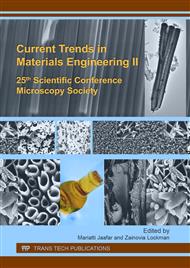p.152
p.156
p.160
p.165
p.169
p.173
p.177
p.182
p.186
Morphology of CuO-Doped Activated Carbon from Kenaf Core Fiber
Abstract:
Mechanochemical process was conducted to synthesis a series of metal oxide doped biomass carbon source followed by carbothermal reduction which obtained via the reaction between activated carbon (AC) and CuO precursor. Microstructure of single AC and CuO-doped activated carbon was conducted using Field Emission Scanning Electron Microscopy (FESEM). Thermal behavior was studied using thermogravimetric analyser and Differential Scanning Calorimetry (TGA and DSC) and crystallinity phase was analysed using X-ray diffraction (XRD). The results indicated that mechanochemical process and carbothermal reduction to synthesis CuO-doped AC have a significant effect in term of surface morphology, thermal decomposition and crystallinity. A significant difference of the surface morphology between AC and CuO-AC samples were observed. TGA/DSC analysis revealed that doping of CuO to AC has affected the exothermic and endothermic reaction of the samples. Doping of CuO to AC also brought a significant increase in the degree of crystallinity due to the carbothermal reduction of CuO into Cu. Production of CuO-doped AC was successfully characterized and revealed the potential enhancement for waste treatment.
Info:
Periodical:
Pages:
169-172
Citation:
Online since:
September 2017
Price:
Сopyright:
© 2017 Trans Tech Publications Ltd. All Rights Reserved
Share:
Citation:


